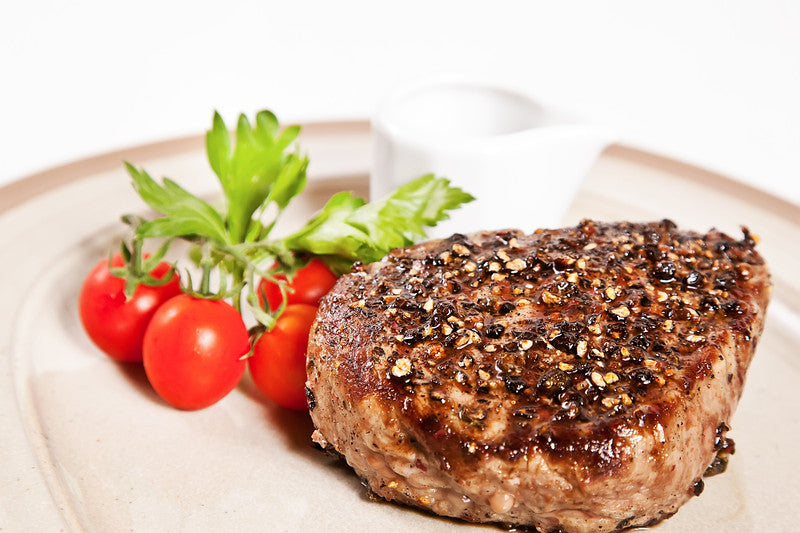
7) Human Health Considerations And Grass-fed Beef Nutrition
Share
Our Meat versus Theirs – Health Implications?
To start, let’s be clear: most of the beef you can purchase in a grocery store is finished (fattened) on a diet of mostly corn and soy. (As discussed in other blogs, this is because it’s faster to fatten a steer on grain than on grass.)
As we’ve stated, our cattle never taste grain. Based on the logic of “you are what you eat,” surely this implies some difference in the meat? Turns out that it does – but like every other aspect of biology, the gut biome, digestion, metabolism, etc. – it’s way too complicated to be easily summarized. And as with other health topics, there's still a lot that we don't know. Here, we’ve tried to compile the facts that we know and that are relevant to human health. We’re open to questions and criticism; just comment and we’ll try our best to respond helpfully!
Basic Nutritional Facts
We looked up the nutritional facts for grass-fed sirloin and grain-finished sirloin, 4 oz each. We found that the grass-fed sirloin had 145 fewer calories, 4.3g less saturated fat, and 5% more iron (daily value). This might seem appealing if you want to be eating leaner meat...but we don't. Most grass-fed beef is slaughtered early (read more about that here), before the animal has had time to fatten. So yes, it's got less fat, but that means it also has less flavor! We want the best-tasting beef possible, so we wait until the animals are fat to slaughter them. This means our meat is probably as caloric as typica
l feedlot meat.

Is Fat Bad?
For years, Americans were told that the fat in red meat was bad for them and caused heart disease. So we replaced the fat in our diet with starches, carbs, sugars... and decades later we're still struggling with heart disease. And we're fatter than ever, right? Turns out, that fat isn't so bad. In fact, it seems beef and pork fat both have a lot of nutritional value. Research shows that "animal fats are of benefit in human nutrition" due to high levels of oleic acid, ideal fatty acid ratios, and micronutrients including vitamins and essential fatty acids. This helps explain the so-called "French paradox" (wherein French folks have been enjoying red meat and wine for centuries and have respectable levels of heart disease). Turns out, it's not a paradox. We proudly produce delicious, fatty meat that has plenty of flavor and juiciness.
Tallow and lard are apparently not the killers we thought they were.
Fatty Acids
Let’s dive deeper into fatty acids. You may have heard about "omega-3 and omega-6 profiles." These are two essential fatty acids that we can't produce and must get from food. The ratio between the two is apparently important. Our ancestors apparently had a "n-6 : n-3 fatty acid ratio" of lower than 4:1 and the WHO has recommended a similarly low ratio for best health.
It turns out that grass-finished beef contains between 2-5 times more omega-3’s, producing a ratio of 1.5:1. Grain-fed, on the other hand, has a ratio of around 7.5:1. So clearly, the grass-fed is well under the WHO recommendation, while the grain-fed is not. Grass-fed beef also contains higher proportions of stearic acid, such that the saturated fat profile contains lower levels of palmitic and myristic acid—which are thought to have negative impacts on our cholesterol.
It seems as far as fats are concerned, grass-fed meat takes the prize!
Vitamins and Minerals
What about vitamin and mineral content? Well, it’s a difference you can both see and taste. Grass-fed beef has a yellower fat, indicating higher levels of carotenoids such as beta-carotene, a precursor to Vitamin A. This is because grasses and "forbs" (farmer-talk for broad-leafed plants) contain much higher levels of these precursors than do soybeans or corn kernels.
Lastly, let’s not leave out the higher Vitamin E content, along with other antioxidants. One interesting tip for grillmasters: the higher antioxidant levels may aid in protecting the meat from cell damage that can occur when grilling it. Lastly, grass-fed beef is mineral-dense, containing higher levels of zinc, iron, phosphorus, calcium, magnesium, and potassium.
(Not Quite) the Last Word...
These nutrition profiles are worth consideration for the long-term impacts of consuming red meat. (They are also thought to extend to other grass-fed animal meats, as you can tell by browsing the Nutritionix site). There is still a long way to go before we really understand this topic, and we look forward to learning more in coming decades, as this type of research is becoming more prevalent. In the meantime, we do our best to responsibly produce what we think is the healthiest meat we can offer.
- Our cattle are fed 100% forage – never grain.
- We do not feed antibiotics, use hormones, or use GMO feed (as we said they don't eat grain anyway).
- Our cattle have access to fresh pasture, year-round.
- Our beef products does not contain sugar, binders, fillers, or MSG.
Further Reading
Please also visit our recent broader, comprehensive discussion of grain-fed vs grass-fed beef
We've also written an informative article for those interested in grass fed beef and environmental impact
Discussions:
http://www.cnn.com/2011/HEALTH...
https://www.healthtoempower.co...
Sources:
https://www.nutritionix.com/food/grass-fed-sirloin
https://chriskresser.com/red-m...
https://www.publish.csiro.au/A...
https://www.healthline.com/nut...
https://en.wikipedia.org/wiki/...
https://www.ncbi.nlm.nih.gov/p...
https://www.healthtoempower.co...
